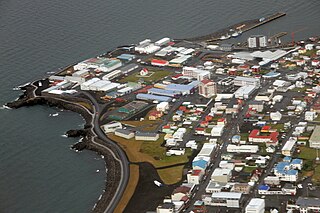
Keflavík is a town in the Reykjanes region in southwest Iceland. It is included in the municipality of Reykjanesbær whose population as of 2016 is 15,129.

The Hunt for Red October is the debut novel by American author Tom Clancy, first published on October 1, 1984, by the Naval Institute Press. It depicts Soviet submarine captain Marko Ramius as he seemingly goes rogue with his country's cutting-edge ballistic missile submarine Red October, and marks the first appearance of Clancy's most popular fictional character, Jack Ryan, an analyst working for the Central Intelligence Agency, as he must prove his theory that Ramius is intending to defect to the United States.

The Cardinal of the Kremlin is an espionage thriller novel, written by Tom Clancy and released on May 20, 1988. A direct sequel to The Hunt for Red October (1984), it features CIA analyst Jack Ryan as he extracts CARDINAL, the agency's highest placed agent in the Soviet government who is being pursued by the KGB, as well as the Soviet intelligence agency's director. The novel also features the Strategic Defense Initiative (SDI), a real-life missile-defense system developed by the United States during that time, and its Russian counterpart. The book debuted at number one on the New York Times bestseller list.

Debt of Honor is a techno-thriller novel, written by Tom Clancy and released on August 17, 1994. A direct sequel to The Sum of All Fears (1991), Jack Ryan becomes the National Security Advisor when a secret cabal of Japanese industrialists seize control of their country’s government and wage war on the United States. The book debuted at number one on The New York Times bestseller list. The novel was later noted as containing plot elements which were similar to the circumstances of the September 11, 2001, terrorist attacks and the hijacking of United Airlines Flight 93.

John Patrick Ryan Sr. (Hon.) is a fictional character created by author Tom Clancy and featured in his Ryanverse novels, which have consistently topped the New York Times bestseller list over 30 years. Since Clancy's death in 2013, five other authors, Mark Greaney, Grant Blackwood, Mike Maden, Marc Cameron and Don Bentley, have continued writing new novels for the franchise and its other connecting series with the approval of the Clancy family estate.
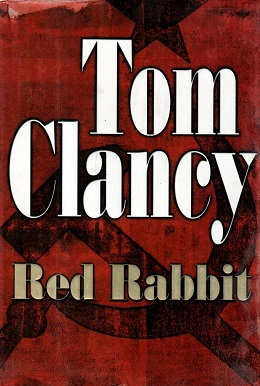
Red Rabbit is a spy thriller novel, written by Tom Clancy and released on August 5, 2002. The plot occurs a few months after the events of Patriot Games (1987), and incorporates the 1981 assassination attempt on Pope John Paul II. Main character Jack Ryan, now an analyst for the Central Intelligence Agency, takes part in the extraction of a Soviet defector who knows of a KGB plot to kill the pontiff. The book debuted at number one on The New York Times Best Seller list.
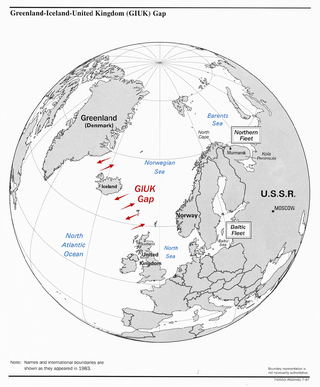
The GIUK gap is an area in the northern Atlantic Ocean that forms a naval choke point. Its name is an acronym for Greenland, Iceland, and the United Kingdom, the gap being the two stretches of open ocean among these three landmasses. It separates the Norwegian Sea and the North Sea from the open Atlantic Ocean. The term is typically used in relation to military topics. The area has for some nations been considered strategically important since the beginning of the 20th century.
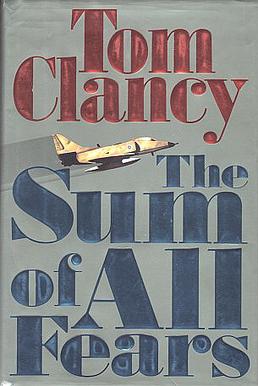
The Sum of All Fears is a political thriller novel, written by Tom Clancy and released on August 14, 1991, as the sequel to Clear and Present Danger (1989). Main character Jack Ryan, who is now the Deputy Director of Central Intelligence, tries to stop a crisis concerning the Middle East peace process wherein Palestinian and former East German terrorists conspire to bring the United States and Soviet Union into nuclear war. It debuted at number one on the New York Times bestseller list. A film adaptation, which is a reboot of the Jack Ryan film series and starring Ben Affleck as the younger iteration of the CIA analyst, was released on May 31, 2002.
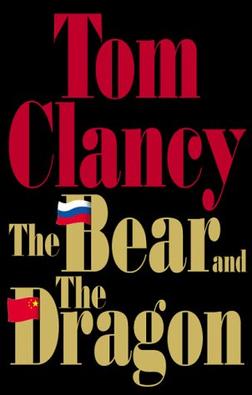
The Bear and the Dragon is a techno-thriller novel, written by Tom Clancy and released on August 21, 2000. A direct sequel to Executive Orders (1996), President Jack Ryan deals with a war between Russia and China, referred respectively in the title as the Russian Bear and the Chinese Dragon. At over 1,028 pages, it is Clancy's longest novel. The book debuted at number one on The New York Times Best Seller list.

SSN is a techno-thriller novel, created by Tom Clancy and Martin H. Greenberg and published on December 1, 1996 as a tie-in to the video game of the same name. It follows the missions of USS Cheyenne, a United States Navy nuclear attack submarine, during a fictional war between the United States and China over the Spratly Islands. SSN is the second Clancy novel after Red Storm Rising (1986) that is not set in the Ryanverse.
Tom Clancy's Ghost Recon is a series of military tactical shooter video games published by Ubisoft. In the series, the player is in charge of a fictional, newly conceived squad of U.S. Army Special Forces soldiers from Delta Company, 1st Battalion, 5th Special Forces Group stationed at Fort Bragg. Except for the "1st Battalion, 5th SFG" designation, this reconnaissance unit is entirely fictional, as Special Forces Battalions currently only support three Companies. They are often referred to as "the Ghosts". Their role is like other real world special operations forces, in that their operations are kept highly classified. In Tom Clancy's Ghost Recon: Future Soldier, it is shown that the Ghost's unit has multiple designations and is part of JSOC; they are also known as the Group for Specialized Tactics, much like real JSOC units such as Delta Force and SEAL Team Six. Tom Clancy's Ghost Recon has also been novelized by Grant Blackwood under the pseudonym David Michaels.

Lawrence L. Bond is an American author and wargame designer. He is the designer of the Harpoon and Command at Sea gaming systems, and several supplements for the games. Examples of his numerous novels include Dangerous Ground, Day of Wrath, The Enemy Within, Cauldron, Vortex and Red Phoenix. He also co-authored Red Storm Rising with Tom Clancy.

The Third World War and The Third World War: The Untold Story are war novels by General Sir John Hackett, published in 1978 and 1982, by Macmillan in New York and Sidgwick & Jackson in London, respectively. The novels detail a hypothetical World War III waged between NATO and the Warsaw Pact in 1985, written in the style of a non-fiction historical retrospective interspersed with accounts of the conflict from the perspectives of various people.

World War III, sometimes abbreviated to WWIII, is a common theme in popular culture. Since the 1940s, countless books, films, and television programmes have used the theme of nuclear weapons and a third global war. The presence of the Soviet Union as an international rival armed with nuclear weapons created persistent fears in the United States and vice versa of a nuclear World War III, and popular culture at the time reflected those fears. The theme was also a way of exploring a range of issues beyond nuclear war in the arts. U.S. historian Spencer R. Weart called nuclear weapons a "symbol for the worst of modernity."

Red Army is a 1989 Cold War-era war novel written by US Army intelligence analyst Ralph Peters. The story explores a Cold War scenario based on a Soviet attack on West Germany across the North German Plain, with defense provided by NATO army corps from the UK, the Netherlands, Belgium, and West Germany.

Red Storm Rising is a simulation video game based on Tom Clancy's 1986 novel Red Storm Rising and released in 1988 by MicroProse. The player is put in charge of an American SSN submarine in the Norwegian Sea Theater with the overall role of a hunter killer performing various missions in the context of the global conflict described in the book representing a campaign. Its original Commodore 64 version was co-designed and co-programmed by the famous game designer Sid Meier.
The following is a complete list of books published by Tom Clancy, an American author of contemporary spy fiction and military fiction.
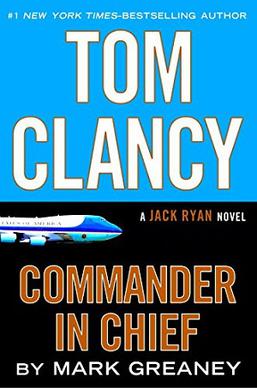
Commander in Chief is a political thriller novel, written by Mark Greaney and released on December 1, 2015. In the book, President Jack Ryan and The Campus must stop Russian president Valeri Volodin from launching a covert violent offensive in an effort to bring back Russia as a superpower. Commander in Chief is Greaney’s third solo entry in the Jack Ryan series, which is part of the overall Tom Clancy universe. The book debuted at number two on the New York Times bestseller list.
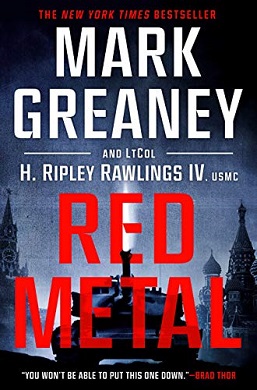
Red Metal is a war novel, written by Mark Greaney and Rip Rawlings and released on July 16, 2019. Set in late December 2020, it features a military conflict between NATO and Russian military forces across two continents, as the latter plots to retake a rare-earth metal mine in East Africa. Red Metal is Greaney's first stand-alone novel and is Rawlings' debut novel. The book debuted on The New York Times, USA Today and Amazon bestseller's lists.

The 234th Guards Air Assault Regiment is a formation of the Russian Airborne Forces. It is part of the 76th Guards Air Assault Division.

















